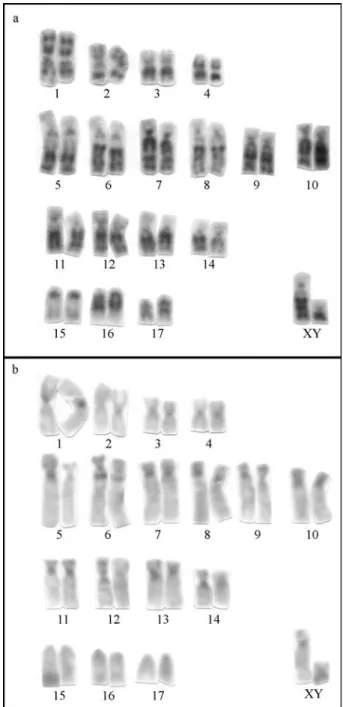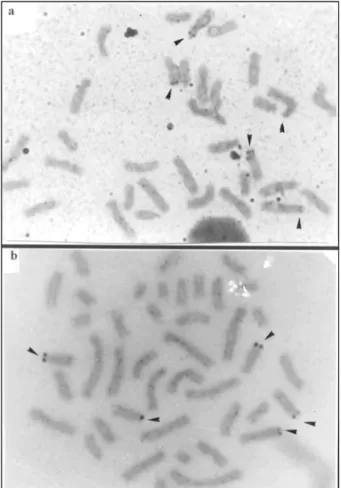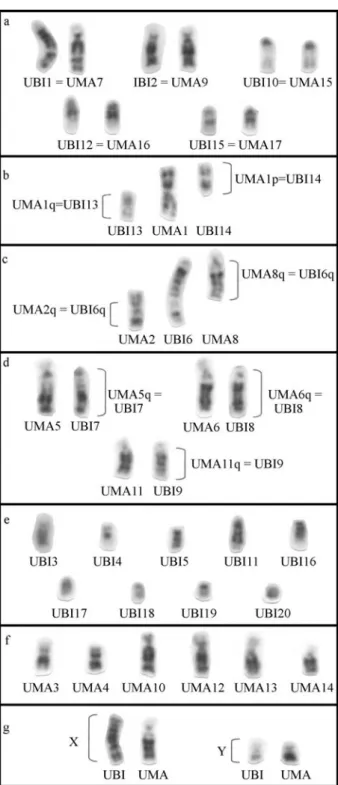Comparative cytogenetic analysis in the species
Uroderma magnirostrum
and
U. bilobatum (cytotype 2n = 42) (Phyllostomidae, Stenodermatinae)
in the Brazilian Amazon
Adailton Moreira da Silva
1, Suely Aparecida Marques-Aguiar
2, Regina Maria de Souza Barros
3,
Cleusa Yoshiko Nagamachi
3and Julio Cesar Pieczarka
31
Universidade Estadual do Amazonas, Centro de Estudos Superiores de Parintins, Parintins, AM, Brazil.
2
Museu Paraense Emílio Goeldi, Departamento de Zoologia, Belém, PA, Brazil.
3
Universidade Federal do Pará, Departamento de Genética, Centro de Ciências Biológicas,
Laboratório de Citogenética, Belém, PA, Brazil.
Abstract
The genusUroderma includes two species: U. magnirostrum and U. bilobatum. These species are characterized by their high degree of karyotypic evolution, diverging from most other species of the subfamily Stenodermatinae, which have a lower degree of chromosomic evolution. The present study reports the first banding patterns of U. magnirostrum (G-, C-banding and Ag-NOR) and U. bilobatum (C-banding and Ag-NOR). The chromosomic data in conventional staining ofU. magnirostrum (2n = 36, NF = 62) and U. bilobatum (cytotype 2n = 42, NF = 50) are equivalent to that described in the literature. When compared, chromosomal homeologies are found in both karyotypes, as well as differences, confirming that karyotypic evolution in theUroderma genus is intense. Fission, fusion, inversion or translocation events are required to explain the karyotypic evolution of this genus. The comparison of karyotype, described here, to one of the species of the genusArtibeus (2n = 30/31), suggests that some chromosomic forms are apomorphic and shared between the two species ofUroderma. This confirms the monophyly of the genus, and that U. magnirostrum presents a more primitive karyotype when compared to U. bilobatum.
Key words:cytogenetics, chromosomal evolution, Phyllostomidae,Uroderma.
Received: November 16, 2004; Accepted: December 14, 2004.
Introduction
TheUrodermagenus is a group of Stenodermatines bats primarily recognized as frugivores with slightly round faces, small snout and lancet nose. They also possesses four facial stripes and a very evident dorsal stripe (Nowak, 1996). Uroderma comprises two species, U. bilobatum
(common) and U. magnirostrum(uncommon), and their
geographic range encompasses southern Mexico to south-eastern Brazil (Hill and Smith, 1984; Nowak, 1996).
The Stenodermatinae subfamily comprises 18 genera (Nowak, 1996) and the relationships of theUroderma
ge-nus with other members of the subfamily are the subject of discussion. The phylogenetic proposals using data from different characters show different associations of the ge-nus Uroderma with other genera of Stenodermatinae.
Using karyotypic information, Gardner (1977) placed this genus as a different lineage, occupying a basal position in the subfamily. Using morphological information, Owen (1987) related Uroderma with Ectophylla and Artibeus
genera. Using molecular data, Van Den Bussche (1992)
suggested that Uroderma is more closely related to Vampyrops andVampyrodes than with the other genera.
With the help of morphological and karyotypic informa-tion, Lim (1993) related this genus strictly toArtibeus, in
spite of the great chromosomal divergence among them.
This genus is an exception to the karyotypic conser-vation found in most species of the Stenodermatinae subfamily, because it presents both intraspecific and interspecific variability (Baker, 1967, 1973, 1979; Varella-Garciaet al., 1989). The speciesU. magnirostrum
had its karyotype described by Baker and Lopez (1970), without banding information. U. bilobatum presents
intraspecific variability with, at least, three chromosomal cytotypes: 2n = 38, 42 and 44 (Baker and Lopez, 1970;
www.sbg.org.br
Send correspondence to Adailton Moreira da Silva. Universidade Estadual do Amazonas, Centro de Estudos Superiores de Parin-tins, Estrada Odovaldo Novo s/n, 69152-470 ParinParin-tins, AM, Brazil. E-mail: amdsilva@uea.edu.br.
Bakeret al., 1972, 1975, 1982). The cytotypes with 2n = 38
and 2n = 44 are derived from three mutational events; two translocation and one centric fusion (Baker, 1979, 1981). The cytotypes with 2n = 42 and 2n = 44 are distinguished by one centric fusion and one pericentric inversion (Baker
et al., 1982).
The Amazonian area is, without a doubt, one of the largest centers of biodiversity on the planet, but little is known about the cytogenetics of the species that are part of this diversity. The objective of this work is to study the karyotype ofU. magnirostrumandU. bilobatum(cytotype
2n = 42) species, collected in the Brazilian Amazon using G-, C-banding and Ag-NOR staining, and to compare the data to the karyotypes already described for both species. They will also be compared to the karyotype ofArtibeus
(2n = 30/31), which is supposed to be the primitive karyotype of the subfamily. This information will be used to define the pattern of chromosomal evolution within the genusUroderma.
Material and Methods
The sample consists of four U. magnirostrum (3M
and 1F) and twoU. bilobatum(1M and 1F) collected in
Belém, Pará, Brazil and were deposited in the Mammal col-lection at the Museu Paraense Emílio Goeldi (MPEG 27271, 27272, 27476, 27557, 27568, 27572). The animals were collected according to Bredtet al.(1996), with the use
of mist nets.
The metaphase chromosomes were obtained using the technique of direct extraction of bone marrow, accord-ing to Ford and Hamerton (1956). The animals were previ-ously submitted to mitotic induction by yeast stimulation, according to Lee and Elder (1980). The G-bands were ob-tained by incubating slides in a solution of 2XSSC (60 °C) from 2 to 10 min and staining in a Wright Giemsa solution (0.25% added to 3 mL of phosphate buffer, pH 6.8) for 2 min and 30 s. The C-banding was performed according to Sumner (1972). The Nucleolar Organizer Regions (NORs) staining was performed according to Howell and Black (1980).
The chromosomes were grouped according to mor-phology and in decreasing size, following Baker and Lopez (1970).
Results
TheU. magnirostrumspecimens presented 2n = 36,
NF = 62 (Figure 1a). The autosome set is composed of 4 metacentric, 10 submetacentric and 3 acrocentric pairs. The X chromosome is a submetacentric of medium size and the Y is a small submetacentric. In one specimen the submetacentric pair 5 showed a heteromorphism in the short arm. The C-banding pattern (Figure 1b) shows that the constitutive heterochromatin is located in the pericentromeric region of all the autosomes and in the distal
region of the short arm of all the submetacentrics. The few exceptions are the heteromorphic pair 5 whose homologues have a interstitial band in the short arm and the pair 6 that has proximal band in the long arm. The X chromosome has centromeric and terminal heterochromatin in the short arm. The Y has a heterochromatic block in the long arm. The number of Ag-NORs ranges from five to eight per metaphase, and they are located in the distal region of the short arm of submetacentric chromosomes (Figure 3a).
TheU. bilobatumspecimens had 2n = 42, NF = 50
(Figure 2a). The autosome set is composed of 5
centric and 15 acrocentric pairs. The X chromosome is a medium sized submetacentric and the Y, a small submetacentric. The C-banding pattern (Figure 2b) shows the constitutive heterochromatin in the pericentromeric re-gion of all the autosomes and in the distal rere-gion of the short arm of two submetacentric chromosomes (pairs 1 and 2). The X chromosome shows centromeric and terminal heterochromatin in the short arm. The Y has a block of heterochromatin in the long arm. The Ag-NORs were lo-cated in the distal region of the short arm of submeta-centric/acrocentric chromosomes (Figure 3b), ranging from five to eight per metaphase.
The G-banding comparison of the karyotypes of the two species ofUroderma(Figure 4) shows homeologies of
whole chromosomes (Figure 4a), segments or arms of chro-mosomes (Figures 4b, 4c and 4d) and chrochro-mosomes that have no correspondence (Figures 4e and 4f). Both species present a chromosomal system of sexual determination of the type Neo-XY, but the G-banding obtained on the sex chromosomes, mainly the X, demonstrates that these chro-mosomes have no similar banding patterns (Figure 4g). The C-banded karyotype ofU. magnirostrum(Figure 1b) shows
a larger amount of heterochromatin thanU. bilobatum
(Fig-ure 2b). The 5-8 multiple Ag-NORs were located in differ-ent chromosomes as can be seen in Figure 3.
Discussion
TheU. magnirostrumspecies, collected in the
Brazil-ian Amazon, has a similar karyotype (2n = 36, NF = 62) to that published by Baker and Lopez (1970) from animals collected in Central America, whose chromosomes were analyzed under giemsa staining. The authors also found two males with 2n = 35, NF = 62, due to the presence of a large metacentric chromosome (possibly originating from a fusion of two acrocentrics), not seen in the present work.
Figure 2- G- (a) and C-banded (b) karyotypes ofUroderma bilobatum.
The unique variation observed was a specimen that showed a heteromorphism in the short arm of the largest submetacentric (chromosome 5). At least three hypotheses could be advanced to explain this heteromorphism: 1) a heterochromatinization in only one of the homologues (see C-banding); 2) amplification of the rDNA cistron (see Ag-NOR banding); 3) a deletion in the short arm of only one of the homologues.
TheU. bilobatumspecies (cytotype 2n = 42), has a
similar karyotype to that published by Baker and Lopez (1970) and Bakeret al.(1982). From a chromosomal
evolu-tion viewpoint, this species is very important, because it possesses karyotypes ranging from 2n = 38 to 44 (Baker and Lopez, 1970; Baker 1979, 1981; Bakeret al., 1982).
According to Bakeret al.(1982), two evolutionary
histo-ries for these karyotypes can be inferred. In the first, there is a trichotomy, because the three karyotypes appeared at the same time, and the cytotype 2n = 44 would represent the primitive condition. In the second, a fusion and an inver-sion separate a group with 2n = 42 and other with 2n = 44/38 and two translocations/fusion separate the 2n = 38 from the 2n = 44. However, even using the data analyzed here and those from the literature, the chromosomal phy-logeny of the cytotypes of theU. bilobatumspecies remains
uncertain, and more chromosomic information is necessary to solve this puzzle.
The high degree of karyotypic homeologies found be-tweenUrodermaspecies reinforces its relationship. They
possess exclusive features such as pair 15 of U. magnirostrumor pair 10 ofU. bilobatumnot found in any
other species of Stenodermatinae bats with G-banded karyotypes described so far. These species also shared two pairs of chromosome (16 and 17 ofU. magnirostrum;12
and 15 of U. bilobatum) that arose by fission of a
metacentric chromosome. These chromosomes have some similarities to the chromosome 4 of A. lituratus (Silva,
2000) and 5 ofPhyllostomus hastatus(Rodrigues, 1998).
According to Bakeret al. (1979), the karyotypes of the
members of the Stenodermatinae subfamily have two chro-mosomes that are not found in any other species of the fam-ily Phyllostomidae, and are considered a plesiomorphic character in theUrodermaspecies.
Taking into account that the karyotype 2n = 30/31 of
Artibeus represents the most primitive for the subfamily
(Bakeret al., 1979; Silva, 2000) and thatU. magnirostrum
might present the most primitive karyotype for the genus, because of the highest similarity toArtibeus, we can infer
karyoevolutionary pathways for the genusUroderma: 1)
one paracentric inversion in the long arm and subsequent fission of the pair 1 ofU. magnirostrumoriginated the pairs
13 and 14 ofU. bilobatum; 2) at least, two fission events
and one fusion in tandem is necessary to explain the
homeologies of the chromosomic segments among pair 6 of
U. bilobatumand pairs 2 and 8 ofU. magnirostrum; 3)
fis-sion events might have occurred also, to give rise to the
acrocentric chromosomes 7, 8 and 9 ofU. bilobatumfrom
the submetacentric chromosomes 5, 6 and 11 of U. magnirostrum, respectively. For the other chromosomes,
the resolution of G-bands was too low to allow good com-parison in small euchromatic areas that suffered chromo-somal rearrangements. However, new techniques of molecular cytogenetics (such as FISH) can help explain doubts that still remain on the chromosomal evolution of this genus.
Regarding the chromosomal systems of sex determi-nation of these two species (neo-XY/neo-XX), Tucker (1986) and Tucker and Bickham (1986) proposed that two chromosomal rearrangements possibly gave rise to the sex chromosomes observed in the karyotypes of the species of Phyllostomidae. First, a translocation X-autosome gave rise to a chromosomal pattern XY1Y2, as observed in most
of the species of theArtibeusgenus. Second, a translocation
Y-autosome originated the Neo-XY pattern, as observed in the species of the present work. Thus, the chromosomal system of sex determination neo-XY is probably derived from system XY1Y2, as corroborated by the similarity in the
size and in the C-banding pattern of the acrocentric chro-mosomes of the system XY1Y2 (genus Artibeus) and
metacentric chromosomes of the system neo-XY (genus
Uroderma).
Our comparative analysis of the two species of
Uroderma allowed us to conclude that they are monophyletic. The species U. bilobatum presents an
apomorphic karyotype, while wholeU. magnirostrum pres-ents a pleisiomorphic karyotype. This last species showed larger number of chromosomal homeologies with the spe-cies of theArtibeusgenus (2n = 30/31), that possess the
pre-sumed ancestral karyotype for the subfamily Stenodermatinae (Baker, 1979; Baker et al., 1979; Lim,
1993). The direction of the karyotypic evolution of the ge-nusUrodermatrended toward an increase in the
chromo-some number by events of fission followed by events of fusion, inversion and/or translocation.
Acknowledgments
We would like to thank CAPES, FINEP, CNPq and UFPA for their financial support and the technicians at the Laboratory of Cytogenetics (CCB/UFPA) and MPEG (Mu-seu Paraense Emílio Goeldi) for field work help and techni-cal support.
References
Baker RJ (1967) Karyotypes of bats of the family Phyllostomidae and their taxonomic implications. Southwest Nat 12:407-428.
Baker RJ (1973) Comparative cytogenetic of the New World leaf-nosed bats (Phyllostomidae). Period Biol 75:37-45. Baker RJ (1979) Karyology. In: Baker RJ, Jones JK and Carter
DC (eds) Biology of Bats of the New World Family Phyllostomatidae. Part III. Special Publications of the
Mu-seum of Texas Tech University, Texas Tech University Press, Austin, pp 107-155.
Baker RJ (1981) Chromosomal flow between chromosomally characterized taxa of a volant mammal, Uroderma bilobatum. Evolution 35:296-305.
Baker RJ and Lopez G (1970) Chromosomal variation in bats of the genusUroderma(Phyllostomidae). J Mammal
51:786-789.
Baker RJ, Atchley WR and McDaniel VR (1972) Karyology and morphometrics of Peter’s tent-making bat, Uroderma bilobatum (Chiroptera, Phyllostomatidae). Syst Zool 21:414-429.
Baker RJ, Bleier WJ and Atchley WR (1975) A contact zone be-tween karyotipically characterized taxa of Uroderma bilobatum(Mammalia, Chiroptera). Syst Zool 24:133-142.
Baker RJ, Bass RA and Johnson MA (1979) Evolutionary impli-cations of chromosomal homology in four genera of steno-dermine bats (Phyllostomidae, Chiroptera). Evolution 33:220-226.
Baker RJ, Haiduk MW, Robbins LW, Cadena A and Koop BF (1982) Chromosomal studies of South American bats and their systematic implications. In: Mares MA and Genoways HH (eds) Mammalian Biology in South America. v. 4. Spe-cial publication Series, Pymatuning Laboratory of Ecology, University of Pittsburgh, pp 303-327.
Bredt A, Araújo FAA, Caetano J, Rodrigues MGR, Yoshizawa M, Silva MMS, Massunaga PNT, Bürer SP, Porto VAR and Uieda W (1996) Morcegos em Áreas Urbanas e Rurais: Manual de Manejo e Controle. Fundação Nacional de Saú-de, Ministério da SaúSaú-de, Brasília, 117 pp.
Ford CE and Hamerton JL (1956) A colchine, hypotonic-citrate, squash sequence for mammalian chromosomes. Stain Technol 31:247-251.
Gardner AL (1977) Chromosomal variation inVampyressaand a
review of chromosomal evolution in the Phyllostomidae (Chiroptera). Syst Zool 26:300-318.
Hill JE and Smith JD (1984) Bats. A Natural History. 2nd edition. University of Texas Press, Austin, Texas, 243 pp.
Howell WM and Black DA (1980) Controlled silver-staining of nucleolar organizer regions with protective colloidal devel-oper: A 1-step method. Experientia 36:1014.
Lee MR and Elder FFB (1980) Yeast stimulation of bone narrow mitosis for cytogenetic investigations. Cytogenet Cell Genet 26:36-40.
Lim BK (1993) Cladistic reappraisal of neotropical Stenoder-matine bat phylogeny. Cladistics 9:147-165.
Nowak RM (1996) Walker’s Bats of the World. 6ª edition. The Johns Hopkins University Press, Baltimore. 285 pp. Owen RD (1987) Phylogenetic analysis of the bat subfamily
Stenodermatinae (Mammalia, Chiroptera). Special Publica-tions of the Museum of Texas Tech University, Texas Tech University Press, Lubbock, Texas. 65 pp.
Rodrigues LRR (1998) Relações cromossômicas entre
PhyllostomuseArtibeus(Phyllostomidae-Chiroptera). Mas-ters Dissertation, Universidade Federal do Pará, Belém. Silva AM (2000) Estudo citogenético e evolução cromossômica
em seis espécies amazônicas da subfamília Stenodermatinae (Chiroptera, Phyllostomidae). Masters Dissertation, Univer-sidade Federal do Pará, Belém.
Tucker PK (1986) Sex chromosome-autosome translocations in the leaf-nosed bats, family Phyllostomidae. I. Mitotic analy-ses of the subfamilies Stenodermatinae and Phyllostominae. Cytogenet Cell Genet 43:19-27.
Tucker PK and Bickham JW (1986) Sex chromosome-autosome translocation in the leaf nosed bats. II. Meiotic analyses of the subfamilies Stenodermatinae and Phyllostominae.
Cytogenet Cell Genet 43:28-27.
Van Den Bussche RA (1992) Restriction site variation and molec-ular systematic of the New World Leaf-nosed bats. J Mam-mal 73:39-42.
Varella-Garcia M, Morielle-Versute E and Taddei VA (1989) A survey of cytogenetic data on Brazilian bats. Rev Bras Genet 12:761-793.


